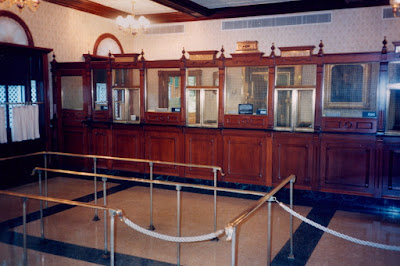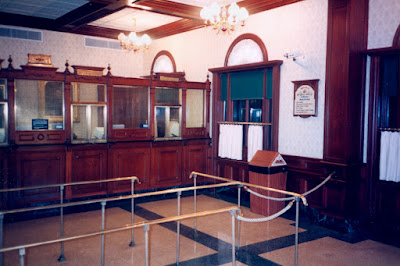Many of the original Space
Mountain's details have changed over the decades but no matter
what version one considers, it's always been an
enigmatic, exciting time. After so many years since my first first ride in the 1970s, I still get
a sense of youthful anticipation sitting in one of its
vehicles waiting to launch. It's just SO GOOD. It was the first WDW ride I remember seeing under
construction as a kid and also the last WDW ride I was trained
to work as an Operations cast member, which was in 1989.
Writing about Space Mountain's history for this site was easy in 1996 since no one on the internet had done that yet. RCA's Home of Future Living, the dog Nipper in a UFO at the
entrance, "Here's To The Future" as a lyric or (and most
importantly) Space Mountain being the only attraction where Blondie made
an appearance... before 2023... I quickly covered all that
stuff just so there'd be mentions of it online and also posted some rare images. What I DIDN'T do was introduce any important
new information about the ride's genesis to the public record, since its
basic origins were already covered in Walt Disney Productions annual reports
or press releases and most interviews about the greater details of how the
ride came to be hadn't even been conducted yet. What I knew
about Space Mountain in the 1990s included, but wasn't rooted in,
how the attraction evolved as a concept for Disneyland. What
I've learned about that since then isn't entirely different than what everyone
else has learned if they were reading The E Ticket, Jason Surrell or blogs like
Progress City. But that's good stuff! And where that tapers
off, I have material to add about the ride
transitioning to WDW.
As with several
other things that Walt Disney had his eye on during the last few years of
his life, a space-themed thrill ride came to Florida first before tracking back
to Anaheim in a new version. The original plan was for a rocket ride in the
style of a Matterhorn sequel of sorts... four tracks veering in and out of
a massive white cone/peak with guests visible in their vehicles to those
standing in front of the attraction. It was part of a project called Space
Port, envisioned for a late-1960s update to Disneyland's Tomorrowland. When
Walt Disney first suggested the ride in 1964, Tomorrowland had been aging for
nine years and he wanted to see it updated in a big way. WED Enterprises' John
Hench came up with Space Port as a centerpiece for the new look of the
land and honed the ride concept for years both before and after Walt's death in
1966. At that time there was no link between the ride and RCA.
In the
company's 1965 Annual Report, the large structure dominating the concept art
was referred to (and only once ever to my knowledge) "Tomorrowland
Mountain." Within WED, the attraction was officially named Space Mountain
sometime around 1967 and referred to by the name in print for the first time in
1969, along with the first published concept art, in A Complete Edition About
Walt Disney World. By this point the ride was designated as being
part of the Florida project, in the Tomorrowland section of Walt Disney World's
Magic Kingdom, and plans for the ride at Disneyland were on hold.
Originally,
plans for WDW's Magic Kingdom suggested that Tomorrowland would open in a
"completed" state along with the rest of the park on October
1st, 1971. As construction progressed, it became clear that the land
would be minimal on opening day compared to its stature in 1969/1970
blueprints. What was now called Space Mountain in pre-opening publications was
still being conceptually developed all the way up to and through the Magic
Kingdom's opening. With that structure being the intended visual anchor of
the area surrounding it, Tomorrowland would be light on attractions
for several years after 1971 and the last part of the park to come together at
the end of what the company referred to WDW Phase One.
Space
Mountain's profile evolved from the more elaborate indoor/outdoor
four-track behemoth envisioned on paper and in a 1969 scale model, made in
conjunction between Arrow Development and (primarily) WED sculptor
Mitsuo Natsume, to an increasingly sleek cone with no outside track
elements, between 1968 and 1972. Arrow Development (1945-1984) was heavily
involved in the design of many early Disneyland rides including the Matterhorn.
For the WDW Space Mountain model, they provided the track portion with WED
enclosing it within slopes of their own making. There was a challenge with
Space Mountain's original four-track design related to the computer control
system that would be needed to operate the ride, since
the technology in 1966 was not advanced enough to complete the
project. When it finally became possible to move forward a couple years later,
the ride was pared back to the two tracks that guests are still
riding today. Looking at models of the final track layouts, it's hard to
imagine four tracks within the current cone or to envision how much larger the
building would need to be if four tracks were
to coexist.
RCA's earliest
involvement with Walt Disney World was either their possible sponsorship of an
Alice In Computerland show (its date and concept details mostly unknown to me
as of November 2021) that became the precursor of EPCOT Center's Astuter
Computer Revue (1982) or
their 1968 effort to sell Disney on their proposed "WEDCOMM" communication
system that would serve the resort as an integrated means of collecting data,
managing reservations and monitoring park and hotel activities. "A
system of Systems, a network of Networks," RCA called it in their 71-page
1969 Project 90 booklet. Reading the full description, it sounds like a hybrid
of a card catalog, 2001:
A Space Odyssey's HAL and the yet-to-come internet. The system
didn't come to fruition and RCA dismantled its computer division in 1971, at
which time WED Enterprises saw an opportunity for getting RCA directly
involved with an increasingly fast-developing new Tomorrowland thrill
ride.
* prophetically, 1969's Project 90 included both textual and
visual references to Space Mountain years before RCA was to sign on as the
attraction's sponsor in 1972. What is NOT referenced in the document is that
rarely-discussed Alice In Computerland show concept.
The
combination of WED and RCA on the project resulted in an attraction design that
went beyond the nature of anything that had come before in its
scale, concept and variety of content. The ride itself would be the first completely
indoor roller coaster in history (capitalizing on that by putting
half the ride in near-total darkness) and the third in Disney's
history, behind Disneyland’s Matterhorn and WDW’s Mr. Toad’s Wild Ride, to have
two distinctly separate tracks. The additional features revolving around RCA's
space cameras/equipment and consumer products were also extensive
enough for Disney to promote the Space Mountain pre-show and
post-show as, combined, an attraction unto itself, warranting a visit
by anyone even if they wouldn't be riding the coaster. Never before had the non-ride portion of a theme park ride been recommended in print as something to
do based on its own entertainment value. And it was genuinely worth that
investment of time.
Sources: Walt Disney Productions annual reports, The E Ticket magazine, The Disney Mountains by Jason Surrell, mitsuonatsume.com, Mike Hiscano, Dave Hooper, Alison Matthews, Tom Morris & even myself because of stuff I learned working at the ride
 |
1964 First rendering of Space Port concept by John Hench
|
 |
Vic Greene, Walt Disney & John Hench with an early model of
Space Port c. 1965 |
 |
| 1965 Walt Disney Productions Annual Report |
.jpg) |
| 1965 Space Port rendering for Disneyland by John Hench, Herb Ryman |
 |
c. 1965 Disneyland Tomorrowland concept by John Hench,
with Space Port in the background
|
 |
| Three c. 1965 John Hench Space Port / Space Mountain concepts |
Above: From 1969's A Complete Edition About WDW, an early rendering by
Carlos Diniz of how Space Mountain might appear in Florida - this was a
Space Mountain / Matterhorn hybrid approach with four separate tracks
running through the attraction
From the cover of 1969's A Complete Edition About WDW, a view of the
WDW's Tomorrowland in concept form - Space Mountain in more of a
"circus tent" shape than the cone that materialized four years late
Three images, of a 1969 Space Mountain model sculpted by Imagineer
Mitsuo Natsume, when the premise was ride tracks that twisted in and
out of the cone structure (images courtesy mitsuonatsume.com)

%20rev.jpg)














.jpg)






















%20rev.jpg)











